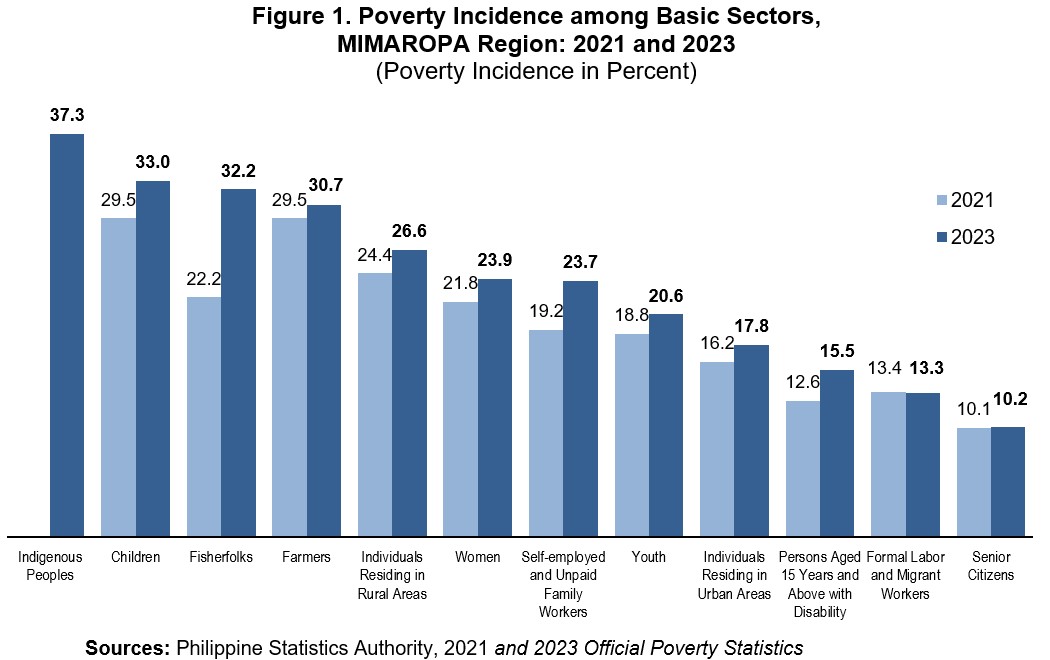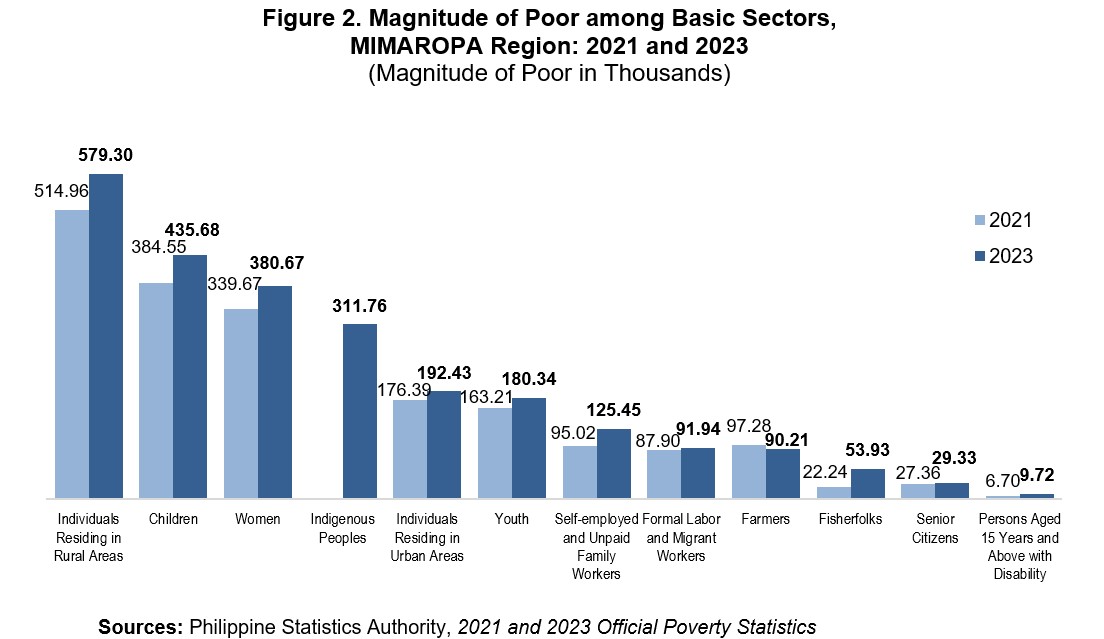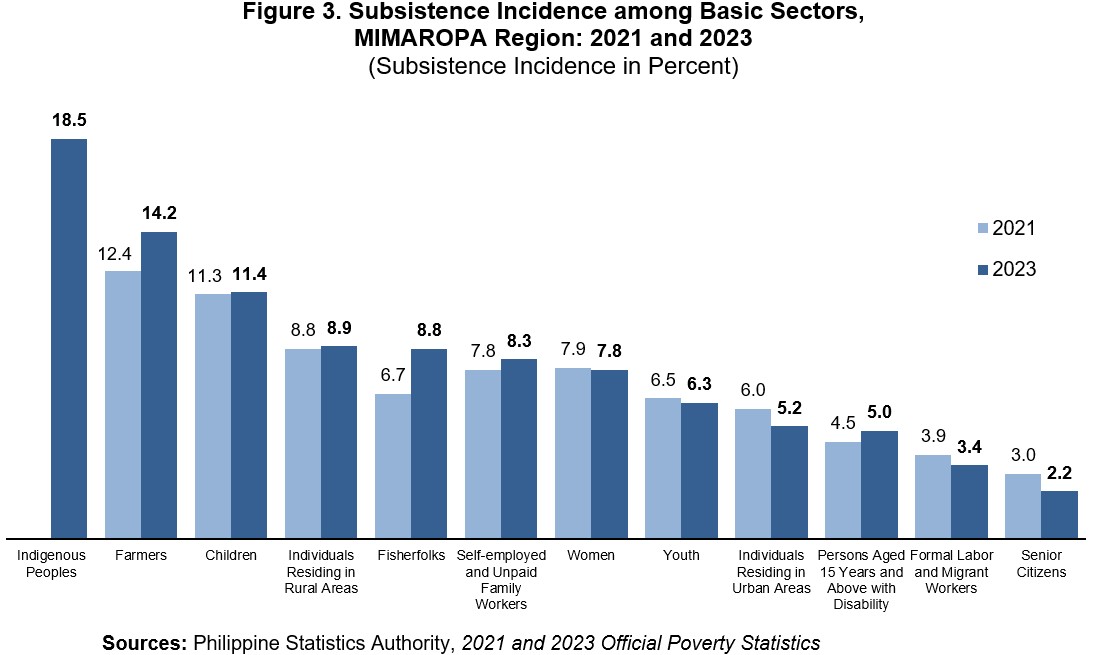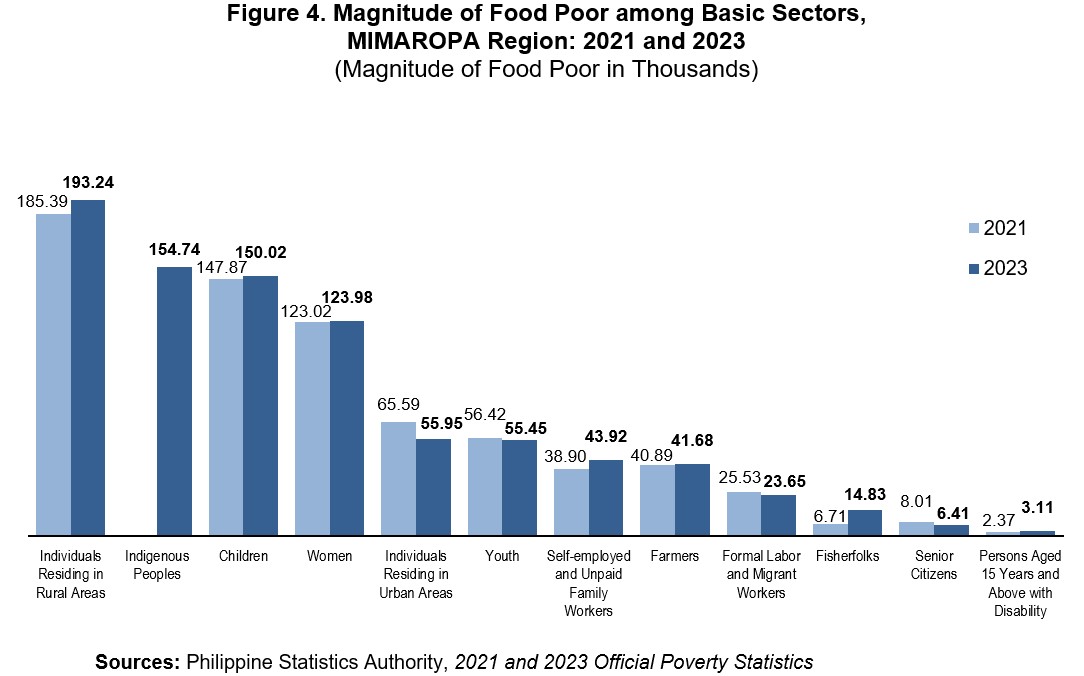Nearly three in every eight Indigenous Peoples were poor in 2023
In the MIMAROPA Region, Indigenous Peoples (IPs) recorded the highest poverty incidence in 2023 at an estimated 37.3 percent. IPs were newly included in the list of basic sectors with reported poverty incidence in 2023. Other sectors that surpassed the 30 percent incidence mark include children (33.0%), fisherfolk (32.2%), and farmers (30.7%). From 2021 to 2023, poverty incidence increased across all basic sectors, except for formal laborers and migrant workers, where it slightly declined from 13.4 percent to 13.3 percent. (Figure 1)

On the other hand, senior citizens (10.2%), formal laborers and migrant workers (13.3%), and persons aged 15 years and above with disability (15.5%) were the three sectors with the lowest poverty incidence in the region in 2023. These sectors also recorded lower poverty incidences in 2021 at 10.1 percent, 13.4 percent, and 12.6 percent, respectively. (Figure 1)
Compared to the years 2021 and 2023, notable increases in poverty incidences were observed across basic sectors. Fisherfolks experienced the most substantial increase, with a rise of 10.0 percentage points, followed by self-employed and unpaid family workers at 4.5 percentage points, and children at 3.5 percentage points. (Figure 1)
Number of poor individuals residing in rural areas reached 579.30 thousand
In terms of magnitude of poor among basic sector, individuals residing in rural areas posted the highest number of poor population in 2023 was estimated at 579.30 thousand. This reflects a 12.5 percent increase from the 2021 figure of 514.96 thousand. Notably, individuals residing in rural areas also held the highest number of individuals in poverty in 2021 estimated at 514.96 thousand. (Figure 2 and Table 2)

Children ranked second highest in terms of the number of poor population in 2023 at 435.68 thousand. This reflects a 13.3 percent rise compared to the 2021 figure of 384.55 thousand. Following closely were women, with an estimated 380.67 thousand facing poverty. (Figure 2)
In contrast, persons aged 15 years and older who have a disability (9.72 thousand), along with senior citizens (29.33 thousand) and fisherfolks (53.93 thousand) constituted the basic sectors with the lowest number of poor individuals in 2023. These sectors also recorded least number of poor individuals in 2021 at 6.70 thousand, 27.36 thousand, and 22.24 thousand, respectively. (Figure 2)
Nearly one out of five IPs were food poor in 2023
In the MIMAROPA Region, IPs showed the highest rates of subsistence poverty in 2023 estimated at 18.5 percent. This means that nearly one in every five IPs to a family that is food poor or a family with income that is not sufficient to buy its minimum basic food needs. This was followed by farmers at 14.2 percent and children with 11.4 percent. In 2021, farmers and children reported the highest subsistence incidence at 12.4 percent and 11.3 percent respectively. (Figure 3)

On the other hand, senior citizens (2.2%), formal labor and migrant workers (3.4%), and persons aged 15 years and above with disability (5.0%) were the three basic sectors recorded the lowest subsistence incidence in the region. (Figure 3)
Several basic sectors in the MIMAROPA Region experienced a decline in subsistence incidence between 2021 and 2023. Most notably, senior citizens recorded the most significant decline of 0.8 percentage points from 3.0 percent in 2021 to 2.2 percent in 2023. Likewise, individuals residing in urban areas also saw a decrease of 0.8 percentage points, dropping from 6.0 percent to 5.2 percent. (Figure 3)
Number of food poor individuals residing in rural areas reached 193.24 thousand
Regarding the extent of food poverty within basic sectors, individuals living in rural areas recorded the highest magnitude of food poor since 2018. It showed an increase of 7.85 thousand or by 4.2 percent from 185.39 thousand in 2021 to 193.24 thousand in 2023. (Figure 4)

IPs ranked second among the largest sector of food poor individuals in 2023, with an estimate of 154.74 thousand. In close succession were children, with an estimated 150.02 thousand experiencing food poverty.
On the other hand, persons aged 15 years and older who have a disability (3.11 thousand), along with senior citizens (6.41 thousand), and fisherfolks (14.83 thousand) comprised the basic sectors with the lowest number of food poor individuals.
(SGD) LENI R. RIOFLORIDO
Regional Director
MLLM / RRL / EVC

